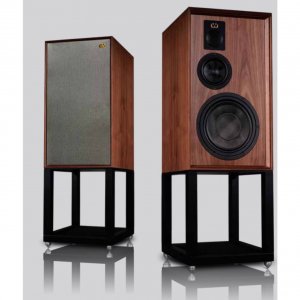- Joined
- Jan 27, 2019
- Messages
- 7,273
- Likes
- 12,175
Obviously there's a lot more nuance than is implied in my sort of click-baitish title (had to keep it short), but...
The question was partially inspired by my listening to this podcast:

Where Peter Comeau if AIG talks about designing the larger new Wharfedale Dovedale speakers, and why smaller/slim speakers tend to be a compromise:

Clearly this is yet another speaker in the trendy "bringing back old school big box wider baffle speaker design" trend, at least in the audiophile world. And it's more that trend, than the specific podcast, that I'm thinking of. Though not strictly limited to the old-school designs...really anything on the subject of why bigger/wider speakers may be desirable vs the slimmer speakers.
Of course any manufacturer/designer can come up with an excuse to hop on the "old school box speaker" design trend. (I'm looking at you, Mo-Fi).
But nonetheless, some make the case based on claims like how bigger speakers are easier to design to sound rich and full, how they can get around some of the baffle-step problems that lead many slim speakers to a lack of body/richness/scale etc.
The arguments for jumping out of the slim speaker paradigm is that the goal of trying to make speakers ever more domestically acceptable pushed speaker designers to ever thinner speakers, with smaller drivers, (and lower sensitivity) which tend to compromise sound for looks.
Personally, I caught the narrow floorstanding speaker "bug" when I heard Audio Physic Virgo speakers in the 90's, and later owned several Audio Physic models. I really loved the way they did not take up much visual space and "disappeared" as apparent sources of the sound, with a big airy soundstage etc.
On the other hand I've also come to appreciate a bigger, beefier sound from some of the more old-school wider-baffle/bigger driver designs. So...I like both.
At the moment I'm using Joseph Perspective floor standing speakers, the very definition of "small, domestically acceptable slim floor standing speaker," which tries to pack a big sound in a smallish speaker. I went back and forth between these and some of the bigger more old school designs. The wider speakers didn't ultimately suit the needs of my room, and I have to say I still quite enjoy the sort of magic act of sitting between widely spaced slim speakers that take up so little visual space yet seem to conjure up a vast soundscape.
What are your thoughts? Did you ever like any slim floor standing speakers? Are you "over them" and happy to go with beefier looking (sounding?) speakers that don't put a slim profile as a premium? And of course any arguments against the 'slim floor standing speakers are compromised' are welcome. (For instance, the new KEF LS60 has been very well received).
The question was partially inspired by my listening to this podcast:
Why BIGGER loudspeakers are BETTER

Darko.Audio podcast: Why BIGGER loudspeakers are BETTER on Apple Podcasts
Show Darko.Audio podcast, Ep Why BIGGER loudspeakers are BETTER - Apr 23, 2023
podcasts.apple.com
Where Peter Comeau if AIG talks about designing the larger new Wharfedale Dovedale speakers, and why smaller/slim speakers tend to be a compromise:

Clearly this is yet another speaker in the trendy "bringing back old school big box wider baffle speaker design" trend, at least in the audiophile world. And it's more that trend, than the specific podcast, that I'm thinking of. Though not strictly limited to the old-school designs...really anything on the subject of why bigger/wider speakers may be desirable vs the slimmer speakers.
Of course any manufacturer/designer can come up with an excuse to hop on the "old school box speaker" design trend. (I'm looking at you, Mo-Fi).
But nonetheless, some make the case based on claims like how bigger speakers are easier to design to sound rich and full, how they can get around some of the baffle-step problems that lead many slim speakers to a lack of body/richness/scale etc.
The arguments for jumping out of the slim speaker paradigm is that the goal of trying to make speakers ever more domestically acceptable pushed speaker designers to ever thinner speakers, with smaller drivers, (and lower sensitivity) which tend to compromise sound for looks.
Personally, I caught the narrow floorstanding speaker "bug" when I heard Audio Physic Virgo speakers in the 90's, and later owned several Audio Physic models. I really loved the way they did not take up much visual space and "disappeared" as apparent sources of the sound, with a big airy soundstage etc.
On the other hand I've also come to appreciate a bigger, beefier sound from some of the more old-school wider-baffle/bigger driver designs. So...I like both.
At the moment I'm using Joseph Perspective floor standing speakers, the very definition of "small, domestically acceptable slim floor standing speaker," which tries to pack a big sound in a smallish speaker. I went back and forth between these and some of the bigger more old school designs. The wider speakers didn't ultimately suit the needs of my room, and I have to say I still quite enjoy the sort of magic act of sitting between widely spaced slim speakers that take up so little visual space yet seem to conjure up a vast soundscape.
What are your thoughts? Did you ever like any slim floor standing speakers? Are you "over them" and happy to go with beefier looking (sounding?) speakers that don't put a slim profile as a premium? And of course any arguments against the 'slim floor standing speakers are compromised' are welcome. (For instance, the new KEF LS60 has been very well received).
Last edited:

